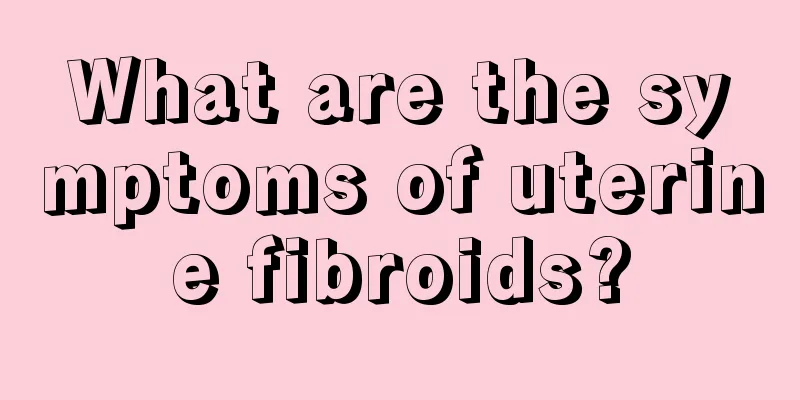What are the symptoms of uterine fibroids?

|
Generally speaking, uterine fibroids will have a certain degree of impact on women's pregnancy rate. The main symptoms of Tasso include irregular menstruation, increased leucorrhea, back pain, abdominal mass, etc. Let's introduce them in detail below. 1. Irregular menstruation Irregular menstruation with increased menstrual flow and prolonged menstrual period is the most common symptom of uterine fibroids. It is more common in large intramural fibroids and submucosal fibroids. Fibroids enlarge the uterine cavity, increase the area of the endometrium and affect uterine contraction. In addition, fibroids may compress the veins near the tumor, causing congestion and dilation of the endometrial venous plexus, thereby causing increased menstrual flow and prolonged menstruation. When submucosal fibroids are accompanied by necrosis and infection, there may be irregular vaginal bleeding or bloody purulent discharge. Long-term excessive menstrual flow may lead to anemia, fatigue, palpitations and other symptoms. 2. Lower abdominal mass When the fibroids are small, no lump can be felt in the abdomen. However, when the fibroids gradually increase in size and the uterus exceeds the size of a 3-month pregnancy, they can be felt from the abdomen. Huge submucosal fibroids can prolapse outside the vagina, and patients may seek medical attention due to prolapse of the vulva. 3. Increased leucorrhea Intramural fibroids increase the area of the uterine cavity, increase the secretion of endometrial glands, and are accompanied by pelvic congestion, which leads to increased leucorrhea. Once submucosal uterine fibroids are infected, there may be a large amount of pus-like leucorrhea. If there is ulceration, necrosis, or bleeding, there may be bloody or purulent vaginal discharge with a foul odor. 4. Compression symptoms Fibroids in the lower segment of the anterior wall of the uterus can compress the bladder and cause frequent and urgent urination; cervical fibroids can cause difficulty urinating and urinary retention; fibroids on the posterior wall of the uterus (isthmus or posterior wall) can cause symptoms such as lower abdominal distension and discomfort and constipation. Broad ligament myomas or giant cervical myomas develop laterally, embed into the pelvic cavity, compress the ureter, and cause obstruction of the upper urinary tract, resulting in ureteral dilatation and even hydronephrosis. 5. Other symptoms Including lower abdominal distension, back pain, and aggravated menstrual symptoms. When the fibroids turn red, there will be acute lower abdominal pain, accompanied by vomiting, fever and local tenderness of the tumor; torsion of the pedicle of subserosal fibroids may cause acute abdominal pain; and abdominal pain may also be caused when submucosal fibroids are discharged from the uterine cavity. Submucosal and intramural fibroids that cause deformation of the uterine cavity can cause infertility or miscarriage. |
<<: What is the reason for the menstrual period not being completed? What factors affect it?
>>: What is the reason for the menstrual period to stop and come again?
Recommend
There is a drug that has a similar mechanism of action to dihydropyridine but is less commonly used to treat blood pressure.
A friend left a message to Huazi, saying that he ...
Can I test positive for pregnancy in 8 days?
Some couples are unable to conceive naturally and...
Are cassia bark and cassia the same? What is the difference between cassia bark and cassia bark?
We all know that cinnamon and cassia are two spic...
Pregnant women urine protein 3
When a pregnant woman's urine protein 3 is hi...
Leaking urine when coughing? This "embarrassing" disease is ignored by many people...
Expert of this article: Zhu Hongjian, Chief Physi...
How many days does it take to sweat during the confinement period
Generally speaking, women need to sit in confinem...
How long does it usually take to conceive?
In daily life, some couples get married late, and...
Is it better for women to have more or less pubic hair?
Pubic hair is basically a physiological character...
How many layers of sutures are needed for caesarean section
The term cesarean section is scary to think about...
What are the characteristics of duck neck? How to cook Juewei duck neck
Duck neck is one of the traditional delicacies in...
Can I do Sanfu moxibustion during menstruation?
Acupuncture is a common health care method, which...
What is the reason for shortened menstrual period?
Women's menstrual period is the most prone to...
What should I do if my menstrual flow is small and my estrogen level is low?
Menstruation is something that every woman must h...
Female endocrine examination costs
The six endocrine tests are what we call the six ...









